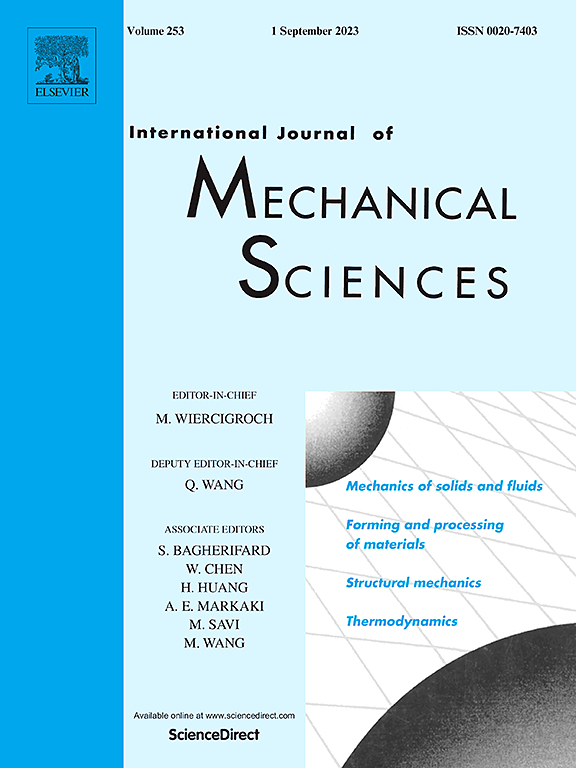Vibro-acoustic suppression in metamaterial sandwich plate using compressional-torsional coupling resonator
IF 7.1
1区 工程技术
Q1 ENGINEERING, MECHANICAL
International Journal of Mechanical Sciences
Pub Date : 2025-02-03
DOI:10.1016/j.ijmecsci.2025.110039
引用次数: 0
Abstract
Reducing low-frequency vibration and sound radiation in lightweight sandwich structures remains a significant challenge due to the inherently long wavelength of low-frequency waves. In this study, we proposed a novel metamaterial sandwich plate with compressional-torsional coupling inertial amplification resonators to effectively attenuate low-frequency vibration and suppress sound radiation. The sandwich plate is integrally fabricated by 3D printing technology. A theoretical model for bandgap prediction is developed using Hamilton's principle. Theoretical, numerical, and experimental results converge to demonstrate that the proposed metamaterial sandwich plate exhibits superior low-frequency bandgap performance while ensuring the lightweight and compactness of the structure. The bandgap starting frequency of the compressional-torsional coupling resonator is 45 % lower than that of the conventional resonator, despite having identical mass and stiffness. Moreover, for the same bandgap starting frequency and stiffness, its mass is only 30 % of that of the conventional counterpart. Crucially, it also occupies significantly less space compared to the lever-type inertial amplification local resonator. This work introduces a promising strategy for the reduction of low-frequency vibration in engineering applications.

求助全文
约1分钟内获得全文
求助全文
来源期刊

International Journal of Mechanical Sciences
工程技术-工程:机械
CiteScore
12.80
自引率
17.80%
发文量
769
审稿时长
19 days
期刊介绍:
The International Journal of Mechanical Sciences (IJMS) serves as a global platform for the publication and dissemination of original research that contributes to a deeper scientific understanding of the fundamental disciplines within mechanical, civil, and material engineering.
The primary focus of IJMS is to showcase innovative and ground-breaking work that utilizes analytical and computational modeling techniques, such as Finite Element Method (FEM), Boundary Element Method (BEM), and mesh-free methods, among others. These modeling methods are applied to diverse fields including rigid-body mechanics (e.g., dynamics, vibration, stability), structural mechanics, metal forming, advanced materials (e.g., metals, composites, cellular, smart) behavior and applications, impact mechanics, strain localization, and other nonlinear effects (e.g., large deflections, plasticity, fracture).
Additionally, IJMS covers the realms of fluid mechanics (both external and internal flows), tribology, thermodynamics, and materials processing. These subjects collectively form the core of the journal's content.
In summary, IJMS provides a prestigious platform for researchers to present their original contributions, shedding light on analytical and computational modeling methods in various areas of mechanical engineering, as well as exploring the behavior and application of advanced materials, fluid mechanics, thermodynamics, and materials processing.
 求助内容:
求助内容: 应助结果提醒方式:
应助结果提醒方式:


